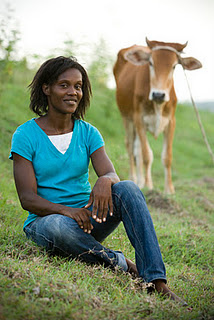It's not news: the world's poor are the most vulnerable to natural disasters. The 2010 Haiti earthquake highlighted this truth to a shocking degree. There are many factors that contribute to the dire poverty that exists in places like Haiti. Heifer International's work is to help farming families build resilient livelihoods, making them less vulnerable to natural disasters, economic changes (like rising commodity food prices) and political shocks.
What does a farm family with a sustainable and resilient livelihood look like? They:

- Have stable and diverse sources of income
- Own secure and productive land
- Have savings and can access formal financing (banks, loans, etc.)
- Can meet their food needs all year, both through their own production and by affording supplemental food from other sources
- Have access to health, education, water, energy, transportation and communication services
- Have a strong voice, especially the women, through cooperatives and associations
Heifer's Rural Entrepreneurs for Agricultural Cooperation in Haiti Project (REACH) is making the above a reality for more than 100,000 Haitians. It's our largest project in Haiti to date, and it will help participating families and communities far less vulnerable to events like the Haiti earthquake of 2010, because they will have the resiliency to bounce back with minimal assistance.
We need help fulfilling our fundraising goals, and you can give directly to REACH today. What will your gift do? This:
- Start family-run breeding centers that will improve the local economy by creating jobs and training participants to provide for improved livestock breeds– something that has never been done before in Haiti.
- Improve Haiti's soil so it will produce better crops, increasing crop production and quality, and ultimately growing enough food that farmers can use to sell for income and build businesses.
- Train Haitian farmers in disaster preparedness and teaching them how to protect their biggest assets–their livestock.
- Protect the environment by placing animals where they are complementary to the crops, and train participants techniques such as zero-grazing, which protects ground cover and makes collecting manure for organic fertilizer easy. Our goal is to leave the environment better than we found it.

We cannot predict the next time a major natural disaster like the 2010 Haiti earthquake will strike. Through REACH, however, we can help ensure at least 100,000 Haitians will be less vulnerable.

